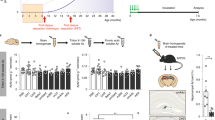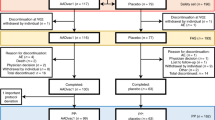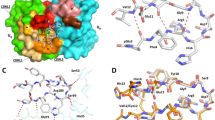Abstract
We have previously shown that chronic treatment with the monoclonal antibody m266, which is specific for amyloid β-peptide (Aβ), increases plasma concentrations of Aβ and reduces Aβ burden in the PDAPP transgenic mouse model of Alzheimer's disease (AD). We now report that administration of m266 to PDAPP mice can rapidly reverse memory deficits in both an object recognition task and a holeboard learning and memory task, but without altering brain Aβ burden. We also found that an Aβ/antibody complex was present in both the plasma and the cerebrospinal fluid of m266-treated mice. Our data indicate that passive immunization with this anti-Aβ monoclonal antibody can very rapidly reverse memory impairment in certain learning and memory tasks in the PDAPP mouse model of AD, owing perhaps to enhanced peripheral clearance and (or) sequestration of a soluble brain Aβ species.
This is a preview of subscription content, access via your institution
Access options
Subscribe to this journal
Receive 12 print issues and online access
$209.00 per year
only $17.42 per issue
Buy this article
- Purchase on Springer Link
- Instant access to full article PDF
Prices may be subject to local taxes which are calculated during checkout




Similar content being viewed by others
References
Hardy, J. A. & Higgins, G. A. Alzheimer's disease: the amyloid cascade hypothesis. Science 256, 184–185 (1992).
Selkoe, D. J. Cell biology of the amyloid β-protein precursor and the mechanism of Alzheimer's disease. Annu. Rev. Cell. Biol. 10, 373–403 (1994).
Neve, R. L. & Robakis, N. K. Alzheimer's disease: a re-examination of the amyloid hypothesis. Trends Neurosci. 21, 15–19 (1998).
Schenk, D. et al. Immunization with amyloid-β attenuates Alzheimer-disease-like pathology in the PDAPP mouse. Nature 400, 173–177 (1999).
Bard, F. et al. Peripherally administered antibodies against amyloid β-peptide enter the central nervous system and reduce pathology in a mouse model of Alzheimer's disease. Nat. Med. 6, 916–919 (2000).
Weiner, H. L. et al. Nasal administration of amyloid-β peptide decreases cerebral amyloid burden in a mouse model of Alzheimer's disease. Ann. Neurol. 48, 567–579 (2000).
Janus, C. et al. Aβ peptide immunization reduces behavioural impairment and plaques in a model of Alzheimer's disease. Nature 408, 979–982 (2000).
Morgan, D. et al. Aβ peptide vaccination prevents memory loss in an animal model of Alzheimer's disease. Nature 408, 982–985 (2000).
DeMattos, R. B. et al. Peripheral anti-Aβ antibody alters CNS and plasma Aβ clearance and decreases brain Aβ burden in a mouse model of Alzheimer's disease. Proc. Natl. Acad. Sci. USA 98, 8850–8855 (2001).
Sigurdsson, E. M., Scholtzova, H., Mehta, P. D., Frangione, B. & Wisniewski, T. Immunization with a nontoxic/nonfibrillar amyloid-β homologous peptide reduces Alzheimer's disease–associated pathology in transgenic mice. Am. J. Pathol. 159, 439–447 (2001).
Dodart, J. C. et al. Behavioral disturbances in transgenic mice overexpressing the V717F β-amyloid precursor protein. Behav. Neurosci. 113, 982–990 (1999).
Dodart, J. C., Mathis, C., Bales, K. R., Paul, S. M. & Ungerer, A. Behavioral deficits in APPV717F transgenic mice deficient for the apolipoprotein E gene. NeuroReport 11, 603–607 (2000).
Dodart, J. C. et al. Neuroanatomical abnormalities in behaviorally characterized APPV717F transgenic mice. Neurobiol. Dis. 7, 71–85 (2000).
Dodart, J. C., Mathis, C. & Ungerer, A. The β-amyloid precursor protein and its derivatives: from biology to learning and memory processes. Rev. Neurosci. 11, 75–93 (2000).
Lue, L. F. et al. Soluble amyloid β peptide concentration as a predictor of synaptic change in Alzheimer's disease. Am. J. Pathol. 155, 853–862 (1999).
McLean, C. A. et al. Soluble pool of Aβ amyloid as a determinant of severity of neurodegeneration in Alzheimer's disease. Ann. Neurol. 46, 860–866 (1999).
Koistinaho, M. et al. Specific spatial learning deficits become severe with age in β-amyloid precursor protein transgenic mice that harbor diffuse β-amyloid deposits but do not form plaques. Proc. Natl. Acad. Sci. USA 98, 14675–14680 (2001).
Games, D. et al. Alzheimer-type neuropathology in transgenic mice overexpressing V717F β-amyloid precursor protein. Nature 373, 523–527 (1995).
Seubert, P. et al. Isolation and quantification of soluble Alzheimer's β-peptide from biological fluids. Nature 359, 325–327 (1992).
Ennaceur, A. & Delacour, J. A new one-trial test for neurobiological studies of memory in rats. 1: behavioral data. Behav. Brain Res. 31, 47–59 (1988).
Dodart, J. C., Mathis, C. & Ungerer, A. Scopolamine-induced deficits in a two-trial object recognition task in mice. Neuroreport 8, 1173–1178 (1997).
Bales, K. R. et al. Apolipoprotein E is essential for amyloid deposition in the APPV717F transgenic mouse model of Alzheimer's disease. Proc. Natl. Acad. Sci. USA 96, 15233–15238 (1999).
Johnson-Wood, K. et al. Amyloid precursor protein processing and Aβ42 deposition in a transgenic mouse model of Alzheimer disease. Proc. Natl. Acad. Sci. USA 94, 1550–1555 (1997).
Acknowledgements
The authors thank R. Gerlai, B. Gitter and P. May for comments on the manuscript and P. Edmonds for editorial assistance.
Author information
Authors and Affiliations
Corresponding author
Ethics declarations
Competing interests
Eight of the authors are employees of Eli Lilly and Company and therefore have a potential financial interest in the work being reported. Several of the authors are listed on patent applications related to the work. Funding of the project came from Eli Lilly and Company. C.M. has no competing financial interests.
Rights and permissions
About this article
Cite this article
Dodart, JC., Bales, K., Gannon, K. et al. Immunization reverses memory deficits without reducing brain Aβ burden in Alzheimer's disease model. Nat Neurosci 5, 452–457 (2002). https://doi.org/10.1038/nn842
Received:
Accepted:
Published:
Issue Date:
DOI: https://doi.org/10.1038/nn842
This article is cited by
-
Cerebrospinal fluid biomarkers of axonal and synaptic degeneration in a population-based sample
Alzheimer's Research & Therapy (2023)
-
Discovery of a novel pseudo β-hairpin structure of N-truncated amyloid-β for use as a vaccine against Alzheimer’s disease
Molecular Psychiatry (2022)
-
Modulating innate immune activation states impacts the efficacy of specific Aβ immunotherapy
Molecular Neurodegeneration (2021)
-
Immune Suppression of Glia Maturation Factor Reverses Behavioral Impairment, Attenuates Amyloid Plaque Pathology and Neuroinflammation in an Alzheimer’s Disease Mouse Model
Journal of Neuroimmune Pharmacology (2021)
-
Alterations in Synaptic Plasticity and Oxidative Stress Following Long-Term Paracetamol Treatment in Rat Brain
Neurotoxicity Research (2020)



